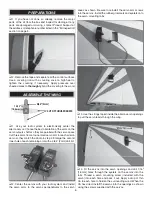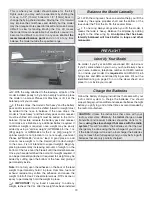
18
GET THE MODEL READY TO FLY
Check the Control Directions
❏
1. Turn on the transmitter and receiver and center the
trims. If necessary, remove the servo arms from the servos
and reposition them so they are centered. Reinstall the
screws that hold on the servo arms.
❏
2. With the transmitter and receiver still on, check all the
control surfaces to see if they are centered. If necessary, adjust
the clevises on the pushrods to center the control surfaces.
FULL
THROTTLE
RUDDER
MOVES
RIGHT
ELEVATOR
MOVES DOWN
RIGHT AILERON
MOVES UP
LEFT AILERON
MOVES DOWN
4-CHANNEL RADIO SET UP
(STANDARD MODE 2)
❏
3. Make certain that the control surfaces and the carburetor
respond in the correct direction as shown in the diagram.
If any of the controls respond in the wrong direction, use
the servo reversing in the transmitter to reverse the servos
connected to those controls. Be certain the control surfaces
have remained centered. Adjust if necessary.
Set the Control Throws
Use a Great Planes AccuThrow (or a ruler) to accurately
measure and set the control throw of each control surface as
indicated in the chart that follows. If your radio does not have
dual rates, we recommend setting the throws at the
low
rate
setting.
NOTE
: The throws are measured at the
widest part
of the elevators, rudder and ailerons.
These are the recommended control surface throws:
ELEVATOR
HIGH RATE
LOW RATE
3/4"
[19mm]
15°
Up
3/4"
[19mm]
15°
Down
5/8"
[16mm]
12°
Up
5/8"
[16mm]
12°
Down
RUDDER
2-5/8"
[67mm]
31°
Right
2-5/8"
[67mm]
31°
Left
1"
[25mm]
11°
Right
1"
[25mm]
11°
Left
AILERONS
15/16"
[24mm]
15°
Up
15/16"
[24mm]
15°
Down
5/8"
[16mm]
10°
Up
5/8"
[16mm]
10°
Down
IMPORTANT:
The Stinger has been
extensively
fl own and
tested to arrive at the throws at which it fl ies best. Flying
your model at these throws will provide you with the greatest
chance for successful fi rst fl ights. If, after you have become
accustomed to the way the Stinger fl ies, you would like to
change the throws to suit your taste, that is fi ne. However,
too much control throw could make the model diffi cult to
control, so remember, “more is not always better.”
Additional note about ailerons:
We strongly suggest you
fl y with low rate ailerons for the fi rst few fl ights to become
accustom to the Stinger II. The high rate aileron has an
aggressive roll rate at faster speeds. If you choose to fl y with
high rate ailerons, plan your fi rst few maneuvers at altitude.
Balance the Model (C.G.)
More than any other factor, the
C.G.
(balance point) can
have the
greatest
effect on how a model fl ies, and may
determine whether or not your fi rst fl ight will be successful.
If you value this model and wish to enjoy it for many fl ights,
DO NOT OVERLOOK THIS IMPORTANT PROCEDURE.
A model that is not properly balanced will be unstable and
possibly unfl yable.
At this stage the model should be in ready-to-fl y condition
with all of the systems in place including the engine or
brushless motor, landing gear, and the radio system (and
battery pack if applicable).
❏
1. Use a felt-tip pen or 1/8" [3mm]-wide tape to accurately
mark the C.G. on the bottom of the wing on both sides of the
fuselage. The C.G. is located 3-1/4" [83mm] back from the
leading edge of the wing.
Summary of Contents for MARINER 40 MK II ARF
Page 24: ......







































